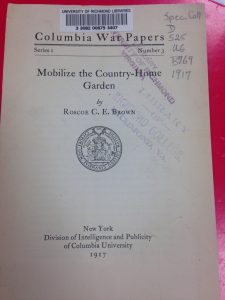
The pamphlet I chose to explore is titled Mobilize the Country Home-Garden, written by Roscoe C. E. Brown and published in 1917 by the Division of Intelligence and Publicity of Columbia University. Mobilize the Country Home-Garden was published in the Columbia War Papers, a series of pamphlets regarding the duties and problems of American citizens during World War I.
The United States’s agricultural production was an integral factor in an Allied victory and US food production sustained both troops and everyday citizens in Europe. As with other aspects of the Great War, the government and war supporters marketed agricultural production as an individual duty, and it is interesting that facilitators behaved as though each citizen’s responsibility to unquestioningly aid the war effort was a foregone conclusion.
In the pamphlet, Brown stresses the need to increase the food supply for the United States and Allied powers. However, he recognizes the difficulty of increasing and supplying labor for large-scale farming and proposes using available land and workforce through personal gardens in country estates. Previously, individual garden’s “addition to food resources has been incidental to their pleasure-giving power”, and Brown characterizes a prioritization of food production as a patriotic act that renounces selfish decadence, for “if need be, let the flower garden be neglected, as well as the fancy borders” (Brown, 4). This focus on pragmatic frugality is seen in that “a considerable part of the produce of the average family garden goes to waste”; whereas in giving produce to national stock, citizens could use available land and labor to aid their country (4). Brown’s appeal to a sense of guilt regarding luxury is fitting of measures at the time that made decadence unfashionable. It is also characteristic of an approach that stressed marketing, manipulation and voluntarism rather than outright force.
The pamphlet avoids exploring how increased production might affect the market, stating that planting is a pressing concern, and “the product can be handled when it is grown” (5). This urgency regarding food production represents an interesting paradox in US involvement; the United States was insulated from physical involvement in the war and could indulge in ideological debate regarding economic policy and the scope of government, yet demand from the Allies for foodstuff and munitions created a sense of pressure. This approach of stressing production and ignoring inflationary effects was typical for the time and contributed to the Great Depression beginning in 1929.
The pamphlet is targeted towards the average citizen traditionally viewed as unimportant to the war effort. Despite the need for large-scale farming, “the owners of the small gardens should realize that they, too, can be of great service”, and that “many small contributions…will make a vast aggregate” (5). This appeal allows the war effort to feel manageable and reaffirms individuality, a central tenet of American values.
Brown ends the pamphlet recapitulating personal responsibility, stating that “the most inexcusable of Idle Acres is the fertile and tended acre that fails to contribute its share to the nation’s staple food supply at a time of national need” (6). This uncompromising affirmation of citizen duty is characteristic of stigma that came with objection to the War and exemplifies the war’s permeation of the domestic sphere and effect on all United States citizens.

I wonder what the role of Columbia University was as an institution. Did they receive federal funding to produce this kind of thing? Something to look into, perhaps.
I wonder what the role of Columbia University was as an institution. Did they receive federal funding to produce this kind of thing? Something to look into, perhaps.